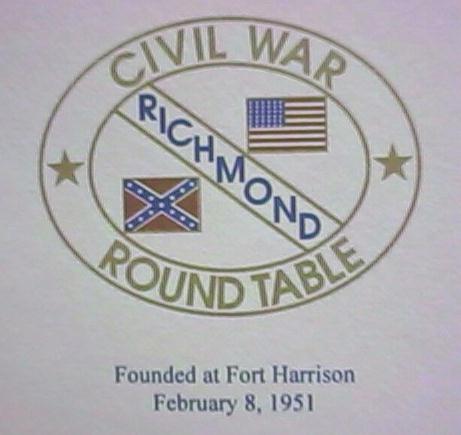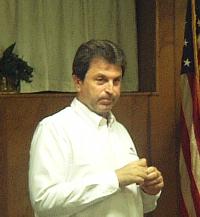


August 2002
rcwrt.org
Clark H. Lewis, President Art & Carol Bergeron, Editors P. O. Box 1122 3901 Paces Ferry Road Richmond, VA 23218 Chester, VA 23831-1239 August 2002 PROGRAM
Scott Bowden "Robert E. Lee and the en échelon attack of July 2, 1863" 8:00 p.m., Tuesday, August 13, 2002, at the Boulevard United Methodist Church, 321 N. Boulevard, Richmond, VA (corner of Boulevard and Stuart Ave.) Scott Bowden is a graduate of Texas Christian University and the author of 22 titles related to Napoleonic and American military history. His most recent work, Last Chance for Victory: Robert E. Lee and the Gettysburg Campaign, has won the 2001 Douglas Southall Freeman History Award, the 2001 General Nathan Bedford Forrest Southern History Award, the 2001 Grady McWhiney Award of Merit, and has officially been named as part of the curriculum at the School of Advanced Military Studies (SAMS) at the U. S. Army Command and General Staff College, Fort Leavenworth, Kansas. By late afternoon on July 2, 1863, elements of the Army of Northern Virginia have fiercely attacked, mauled and driven back a significant portion of the Federal Army of the Potomac. As a result of this attack, numerous "opportunities" (to use Lee's description) have developed along the Federal line, but none more important than those along Cemetery Ridge north of the Copse of Trees. On this ground facing west towards the Confederates of A. P. Hill's Third Corps are only a half-dozen brigades, and four of these belong to the dubious Eleventh Corps. The reason this ground is so thinly held is because many other Federal formations previously positioned on this ground have long since been moved by Meade and Hancock to the left wing of the embattled Federal army in the attempt to stem the Confederate tide. Poised to strike the Federals that remain on this crucial ground are two veteran brigades of Anderson's Division as well as the four hard-fighting brigades of the famed Light Division under the aggressive leadership of Dorsey Pender. Lee's modified plan that Thursday to attack "en échelon" has indeed delivered to his subordinates what is arguably the most significant "opportunity" ever presented to the Army of Northern Virginia. Robert E. Lee's modified plan to attack "en échelon" at Gettysburg on July 2 ranks among the least understood events in American military history. Proper examination of the attack "en échelon" will help students of the War Between the States comprehend and appreciate Lee's unique genius.
Review of the July Program
 |
Announcements
Fall Tour On October 5, our fall tour will take us to Brandy Station. Clark B. "Bud" Hall, who was one of the driving forces behind the preservation efforts at that battlefield, will serve as tour guide. The cost is very reasonable-just $20 per person. We will depart from the WalMart parking lot at Brooke and Parham at 8 a. m. and return about 5:30 p. m. Everyone should bring a lunch and their own drinks. We will provide pastries and fruit as breakfast, as well as cookies for an afternoon snack. This promises to be one of the best trips the Round Table has been on because we will have access to some areas not normally open to the public.
Museum of the Confederacy Seeks Volunteers The Museum of the Confederacy will hold its annual fund raising event weekend, Celebrate South, on April 4-6, 2003. Each year the event recognizes a different southern state, and Florida will be the theme for 2003. Guests from around the country will enjoy educational events, workshops, an auction, and the annual Civil War-themed ball, which comes complete with period costumes and dancing. Information on this event will be posted as it become available at www.moc.org. Celebrate South is planned by a committee of dedicated and interested volunteers. There is particular need for volunteers with fund-raising or marketing experience. If interested, please see Carol Bergeron at the next meeting.
Book Signing Scheduled Pamplin Historical Park near Petersburg will host a book signing on Saturday, August 17. Art Bergeron and Lawrence L. Hewitt will available to autograph copies of their new book Louisianians in the Civil War, published by the University of Missouri Press. The signings will be held from 1-2 p.m. and again from 4-6 p.m. Copies of the book will be available for sale in the park's Museum Store. There is no admission charge for this special event. For more information, call Pamplin Historical Park at (804) 861-2408.
New Online Newsletter Feature The online edition of our newsletter now features an articles section. They are under the link: RCWRT Members' & Speakers' Articles & Speeches on our home page. Dr. Edward Smith has sent an article that is an 800 line copy of his 1992 speech. The latest article, by our November speaker, is just a link to another web site. Members should submit to Gary Cowardin any published articles and permission to reproduce them on the web site. Gary will put them in the appropriate location. He will need to receive the articles in e-mail format, attachment, FAX, or paper with the preference in that order (e-mail preferred). We can also link to another web site if necessary. Each article will need to be approved as submitted to avoid any negative situations (language, continent, etc.).
RCWRT Monthly Speakers for 2002
Newsletter Deadlines To facilitate the printing and timely distribution of the monthly newsletter, information for it should be submitted to the editors no later than the following dates: August 23 for September September 20 for October October 18 for November November 22 for December
Richmond Civil War Round Table Newsletter Art & Carol Bergeron, Editors 3901 Paces Ferry Road Chester, VA 23831-1239
Return to News Letters Index
Return to main page

©R.C.W.R.T. 2002